Key takeaways:
- Diversity in hiring enhances innovation and creativity by bringing together varied perspectives, leading to more effective problem-solving.
- Creating an inclusive atmosphere goes beyond just hiring; it involves fostering a culture where all voices are valued and heard.
- Addressing unconscious bias and implementing structured hiring processes are crucial for ensuring fair assessments and embracing diverse talent.
- Continuous engagement and mentorship are essential for the growth of diverse team members, reinforcing the importance of an inclusive work environment.
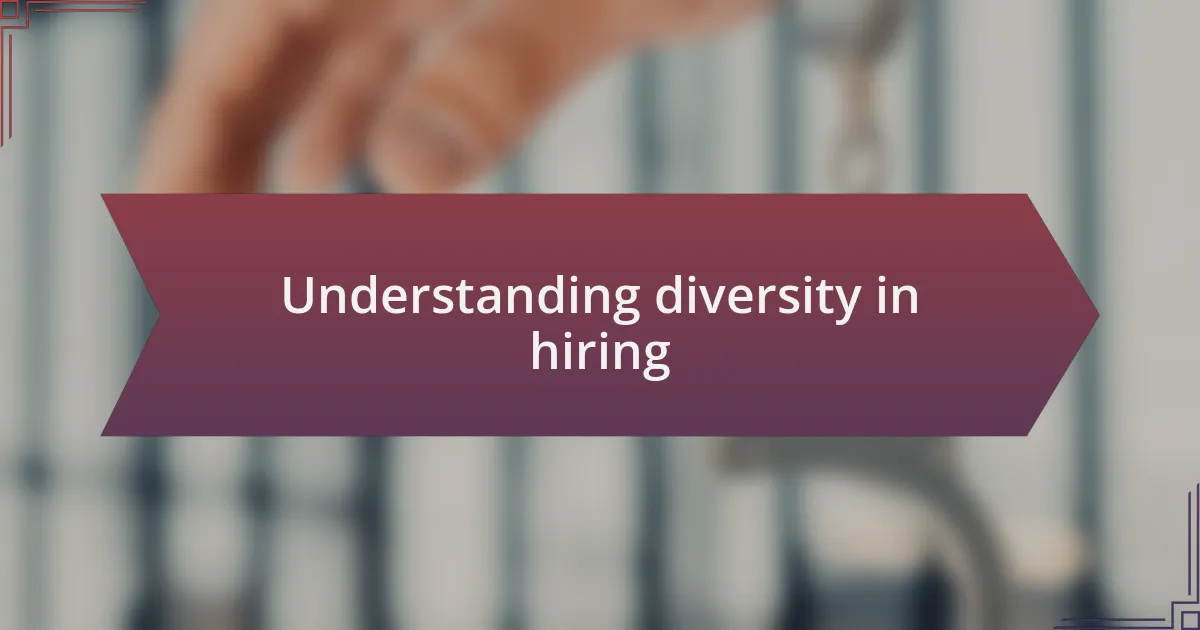
Understanding diversity in hiring
Diversity in hiring means bringing together individuals from various backgrounds, experiences, and perspectives. I remember when I first realized the importance of this; I once partnered with a colleague from a different culture for a project. The unique viewpoints we shared not only enhanced our work’s quality but also deepened my appreciation for the richness that diversity brings to a team.
When I think about diversity, I can’t help but consider how various voices contribute to a more innovative environment. Have you ever noticed how brainstorming sessions filled with diverse team members yield creative solutions far beyond what a homogenous group might achieve? Personally, I’ve experienced this firsthand—one multi-cultural team I worked with generated an idea that transformed our strategy, all because we combined our varied insights.
It’s also essential to understand that embracing diversity in hiring isn’t just about checking boxes; it’s about cultivating an inclusive atmosphere where everyone feels valued. I recall mentoring a new hire who offered a fresh take on our client approach, making me reflect on how my experiences shaped my viewpoint. This exchange highlighted my belief: diverse teams foster growth not only for the business but also for each individual’s personal journey.
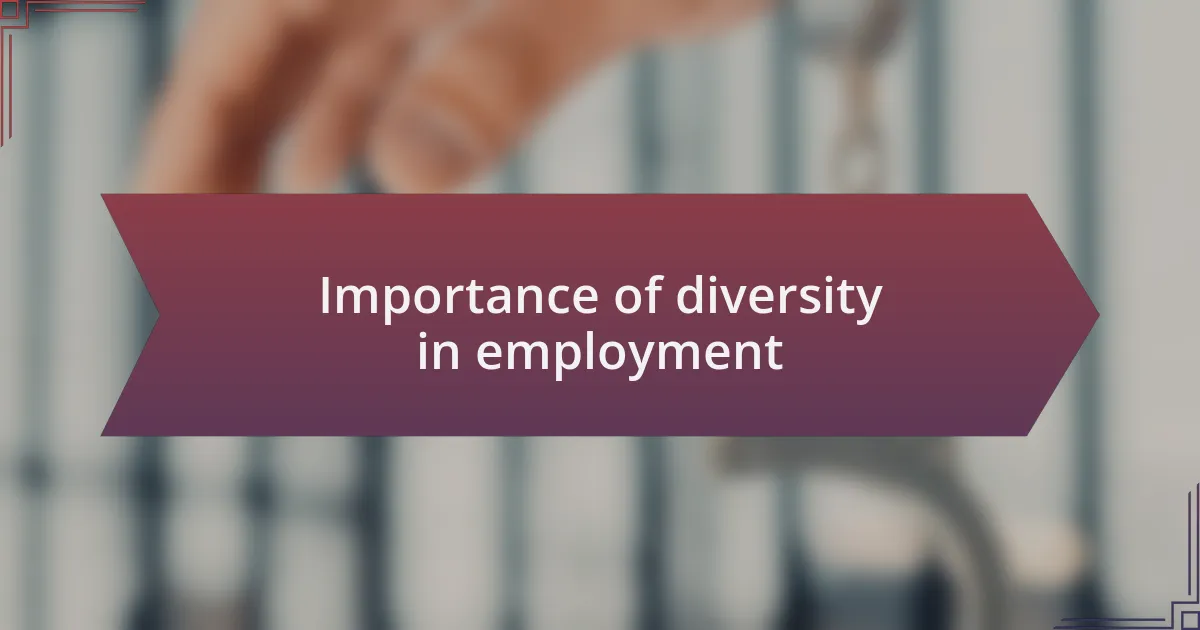
Importance of diversity in employment
Diversity in employment isn’t just a trendy topic; it fundamentally changes how an organization operates and connects with its audience. I recall a time when my team was struggling to relate to a diverse client base. Bringing in team members from various backgrounds helped us better understand our clients’ needs. It was a lightbulb moment when we realized that our insights directly influenced our success.
When diverse perspectives come together, they create an environment where innovative solutions thrive. I can remember a meeting where someone brought a radically different approach that initially seemed unconventional. However, after some discussion, we discovered it offered a fresh angle that turned out to be pivotal for our project’s success. Have you ever felt that surge of energy when a new idea clicks? It’s exhilarating and showcases how essential diversity is in fostering creativity.
Moreover, diversity in the workplace leads to a more engaged and satisfied workforce. I once worked in a company where diversity wasn’t prioritized, and I noticed many talents feeling frustrated or overlooked. It became clear to me that inclusivity goes beyond hiring; it’s about creating a culture where everyone thrives. By embracing diverse hires, we build not just diverse teams, but a richer community where collaboration shines.
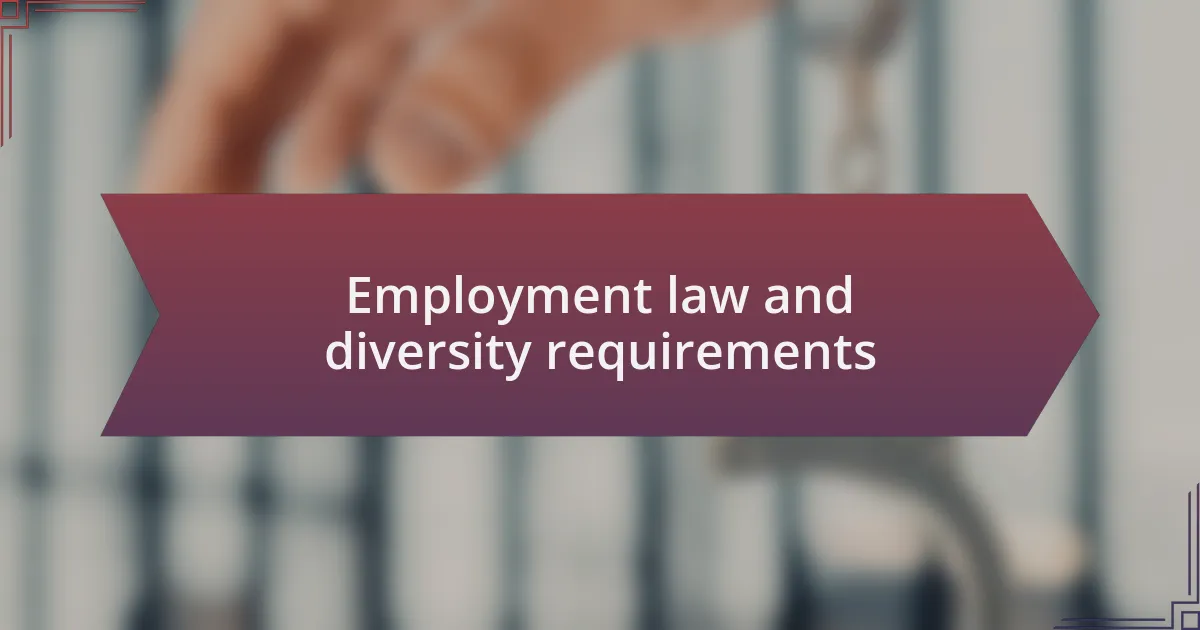
Employment law and diversity requirements
When discussing employment law and diversity requirements, it’s essential to understand the legal framework that supports these initiatives. For instance, laws like the Equal Employment Opportunity Commission (EEOC) prohibit discrimination based on race, gender, or disability, pushing organizations to not only comply but to actively pursue diverse hiring practices. I once witnessed the transformation of a hiring team that shifted its approach to align with these requirements—they went from merely checking boxes to genuinely valuing the richness that diversity brings.
Additionally, some states have begun to implement regulations that encourage, or even mandate, affirmative action policies. These measures aim to address historical imbalances in hiring. I remember a workshop where an HR manager shared how they restructured their outreach to underrepresented communities. It wasn’t just about following the law; it became a passionate commitment to ensure voices that had long been silenced were finally heard.
Engaging with these diversity laws fosters a greater sense of accountability and can translate into tangible benefits for the workplace culture. Have you ever noticed how a team becomes more resilient and adaptable when it reflects a variety of experiences? That’s because inclusion encourages collaboration and problem-solving in ways that a homogenous group simply cannot.

Strategies for diverse hiring practices
To foster diverse hiring practices, one effective strategy is to expand recruitment efforts beyond traditional channels. I remember when my team decided to partner with local community organizations and colleges that serve underrepresented populations. This not only broadened our talent pool but also brought in fresh perspectives that enriched our workplace culture. Have you ever thought about how different connections could uncover hidden talent in your own community?
Another vital approach is to implement unbiased screening processes. In my experience, structuring interviews with standardized questions and using diverse interview panels help mitigate unconscious bias. By focusing on skills and qualifications rather than personal attributes, we can ensure that each candidate is evaluated fairly. It’s amazing how small changes in our approach can lead to significant shifts in who we invite to join our teams.
Additionally, providing training on diversity and inclusion for all hiring personnel can be a game changer. I once participated in a workshop that highlighted common biases and taught techniques for recognizing and overcoming them. This experience opened my eyes to the subtle ways our choices shape our teams, and I have since observed how a well-informed hiring panel can attract and retain a diverse workforce. Wouldn’t it be fulfilling to know that your team reflects the rich tapestry of society?
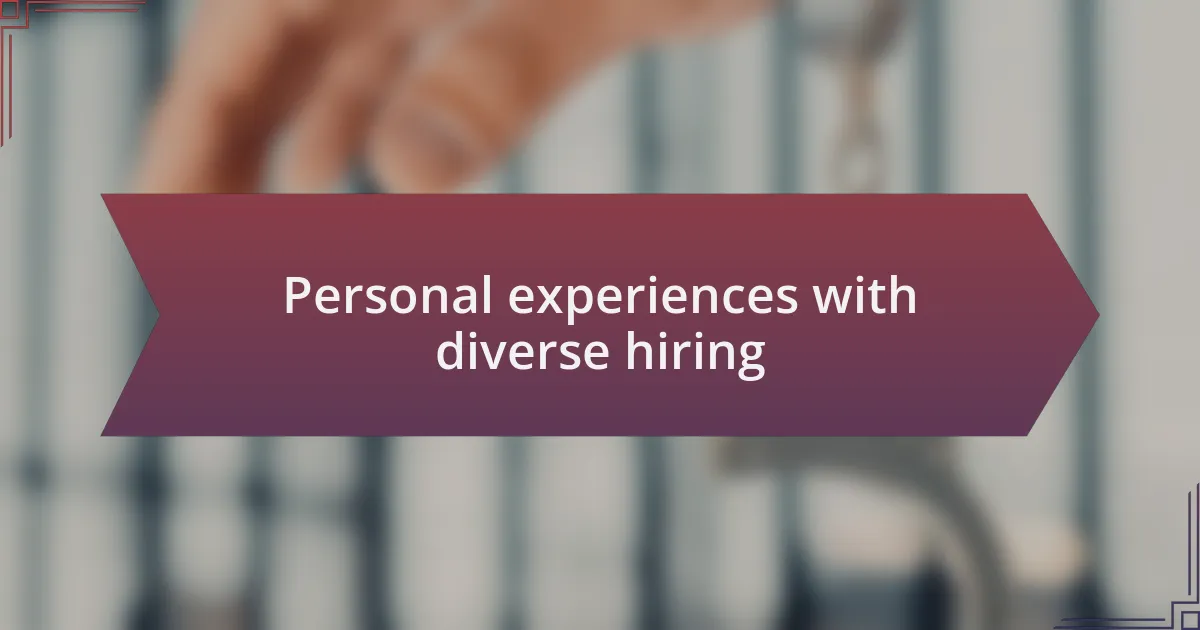
Personal experiences with diverse hiring
Throughout my career, I’ve found that welcoming diverse hiring leads to transformative experiences. One time, I hired a candidate from a different cultural background who brought a unique perspective to our project. The insights she shared not only changed the way we approached problems but also inspired the team to think more creatively and empathetically. Have you ever experienced that “lightbulb moment” when a fresh viewpoint shifts the entire dynamic?
In another instance, I worked with a candidate who had a non-traditional career path. At first, I hesitated, wondering if he would fit into our established environment. However, once he joined, his unconventional experiences introduced innovative strategies that reshaped our processes. This taught me that diverse backgrounds often equate to exceptional skills that aren’t always found in a linear career trajectory. How often do we overlook talent simply because it doesn’t fit our preconceived notions?
Reflecting on these moments, it’s clear that embracing diversity in hiring wasn’t just a box to check; it was a pathway to growth and enrichment. Every new hire brought a story that added depth to our team narrative, reminding me that our collective strength lies in our differences. It’s fascinating to think how every choice can influence not just our work environment but also our personal growth. What stories would your hiring choices tell?
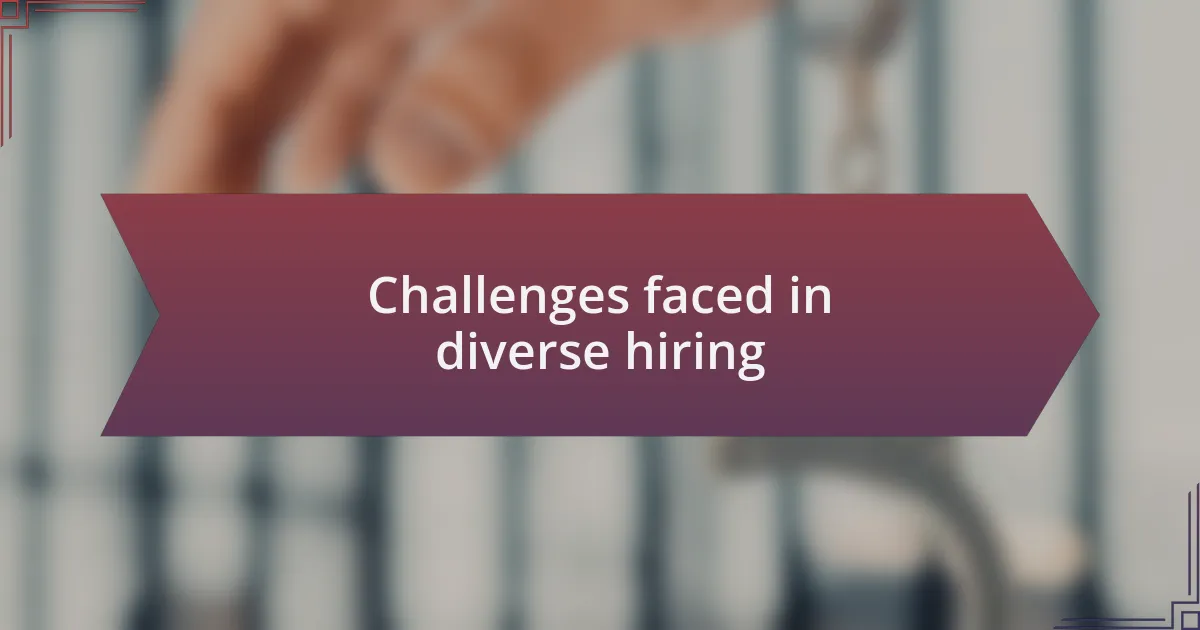
Challenges faced in diverse hiring
Diverse hiring can often lead to unanticipated challenges. For instance, I remember a time when our team struggled to find common ground due to differing communication styles. The variations in how people from different backgrounds perceive feedback created misunderstandings that took time to resolve. It made me realize: how crucial is it to cultivate a culture of open dialogue, especially when diverse perspectives are at play?
Another challenge I faced was the unconscious bias that can sneak into the hiring process. During interview sessions, I found myself inadvertently favoring candidates who mirrored my own background. I had to confront this bias head-on, which prompted me to ask myself: how can we foster a fairer assessment process that truly values diversity? Implementing structured interviews was a step forward, but it was a wake-up call to continuously reflect on my own assumptions.
Moreover, there’s the hurdle of ensuring inclusivity once hires are made. In one project, despite having a diverse team, certain voices felt marginalized during discussions. This experience taught me that hiring diverse individuals is just the beginning; creating an environment where everyone feels valued and empowered to share their ideas is a journey that requires ongoing commitment. How do we ensure that all team members feel heard and respected? Addressing these challenges directly can lead to a more cohesive and innovative team.
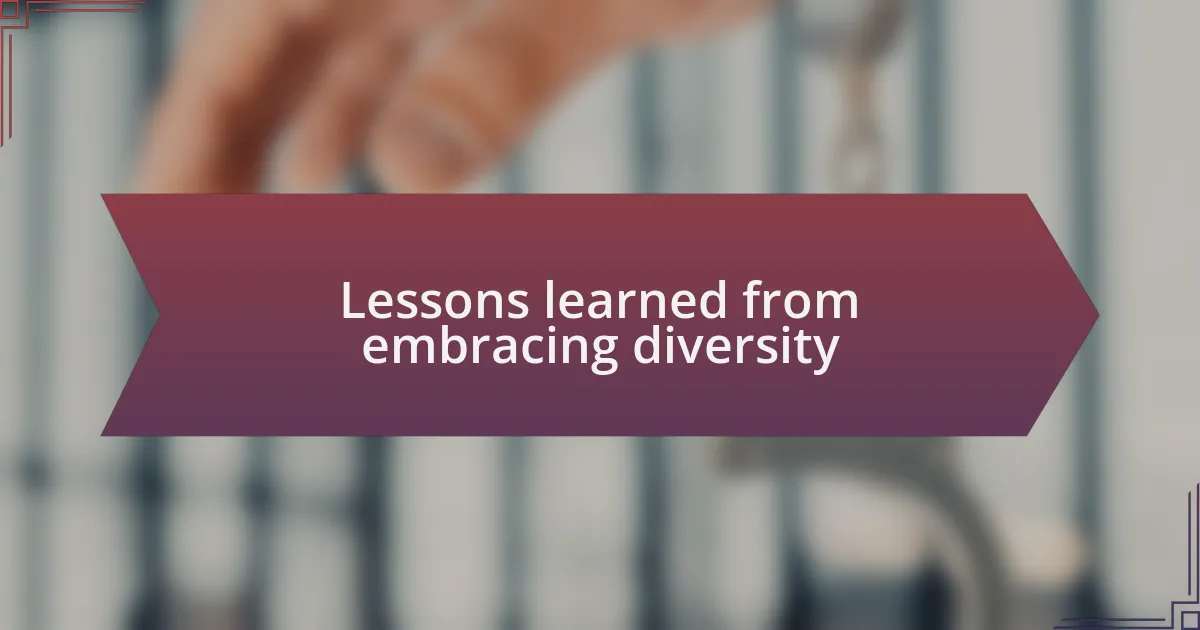
Lessons learned from embracing diversity
Embracing diversity in hiring taught me that each individual’s unique background brings invaluable perspectives to the table. I once worked on a project where our team included members from various cultural backgrounds. I was surprised by how their different approaches to problem-solving led us to innovative solutions that I had never considered. This experience reinforced my belief that diverse teams can fuel creativity in ways that homogenous groups often cannot.
One poignant lesson was the importance of mentorship and allyship. I recall a colleague who faced challenges in adjusting to our company culture. By taking the time to understand her experiences and offering guidance, I witnessed her transformation into a strong contributor. This taught me the impact of investing in the growth of diverse team members, raising an essential question: how often do we actively seek to uplift those who may be struggling?
Finally, I learned that celebrating diversity goes beyond just hiring—it requires ongoing engagement and inclusion. During a team-building event, I noticed how sharing personal stories about our backgrounds created bonds that strengthened our collaboration. This highlighted the importance of fostering relationships that celebrate differences. I often ask myself: what more can I do to deepen connections and ensure everyone feels they truly belong?